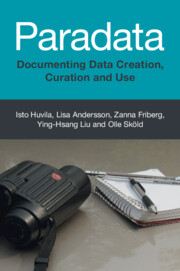The story of this book goes back either a couple of years, half a decade or a quarter of a century depending on where the starting point of this particular process is set. The bulk of the text was written in 2023 and during the first half of 2024. The preparations for writing started sometime in 2021 or 2022, when the book proposal was submitted or accepted. Another reasonable point of time could be the time when Isto started drafting a research proposal for the European Research Council in 2017, or a few years earlier when the question of paradata – to put it simply, information on diverse practices and processes – started to reemerge in previous projects as a crucial question in archaeologists’ information work. Going back in time, yet another starting point could be the time when Isto’s interest in studying the documentation of archaeological 3D visualisations started in the late 1990s, a process that is partly documented and reported in his doctoral thesis from 2006. Some of the work in the middle can be found in the list of references of this volume and the lists of references of the cited references. At the same time, this volume is also a collaborative effort that builds in different ways on the studies we have done and the lengthy discussions we have had on the nature and practice of paradata since mid-2019.
You might wonder why we go into this much detail in outlining where this particular book process started. It is after all conventional in a preface to set a starting point whether it is the somehow real starting point or something that is convenient to mark as the beginning of a believable origin story without turning it into a research problem. For our book, however, this is important as it is what this volume and our work in the CApturing Paradata for documenTing data creation and Use for the REsearch of the future (CAPTURE) project between 2019 and 2024 has been all about: to understand how processes and practices are understood, described and documented, and preserved.
Tracking the process (or practice – depending on perspective and theoretical framing) of writing this book provides an illustrative example of how difficult it can be to figure out when a process starts and ends not to mention how to trace them back in time and how to document them in such detail that is useful and makes sense for future use. However, it is also fair to note that even if writing this book was far from straightforward, it is not exemplary of a spectacularly complicated undertaking. The practices and processes we have been investigating in the CAPTURE project that this book builds on, have been often much more convoluted in terms of how they unfold, and how many actors, material and conceptual things are engaged.
In spite of the diversity of their nature, scale and complexity, a common denominator for both writing this book and the instances of data work we have studied as a part of our empirical work is that understanding practices and processes matters when trying to make sense and utilise their outputs and underpinnings. Paradata obviously plays a key role in conveying such an understanding. However, similarly to the practices and processes themselves, the paradata itself is complex and diverse, multimodal, deeply ingrained and relational to practices and processes and their constituting elements. The cover of the book is here to remind us of how it is itself a part of what it conveys. Without being able to identify, keep and convey relevant paradata – in all of its complexity, which we venture to exemplify in this volume – there would hardly be any use or reuse of data or, for that matter, anything that comes out of it.
